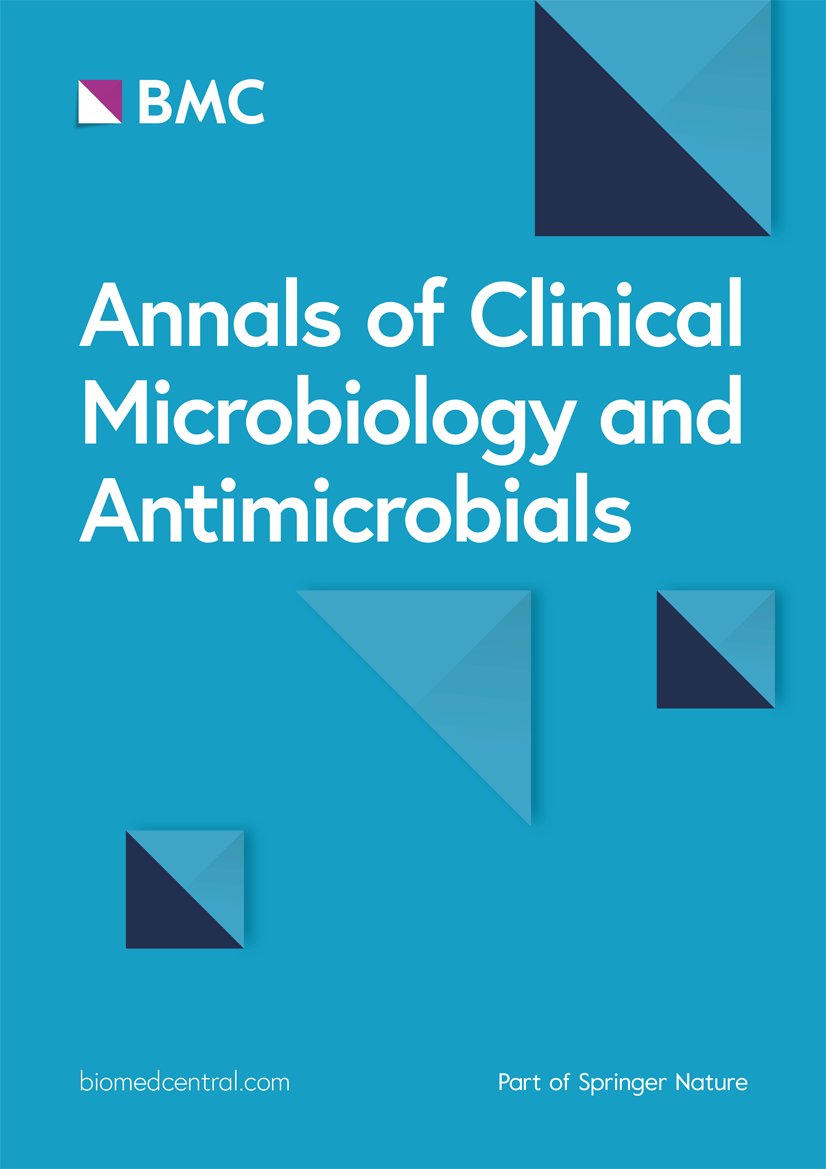Quenching of quorum sensing in multi-drug resistant Pseudomonas aeruginosa: insights on halo-bacterial metabolites and gamma irradiation as channels inhibitors
IF 4.6
2区 医学
Q1 MICROBIOLOGY
Annals of Clinical Microbiology and Antimicrobials
Pub Date : 2024-04-10
DOI:10.1186/s12941-024-00684-5
引用次数: 0
Abstract
Anti-virulence therapy is a promising strategy to treat multi-drug resistant (MDR) pathogens. Pseudomonas aeruginosa is a potent opportunistic pathogen because of an array of virulence factors that are regulated by quorum sensing systems. The virulence features of four multi-drug resistant P. aeruginosa strains were investigated upon exposure to the sub-lethal dose of gamma rays (1 kGy), and sub-inhibitory concentrations of bioactive metabolites recovered from local halophilic strains in comparison to control. Then, the gene expression of AHL-mediated quorum sensing systems (las/rhl) was quantitatively determined in treated and untreated groups by real-time PCR. The bioactive metabolites recovered from halophilic strains previously isolated from saline ecosystems were identified as Halomonas cupida (Halo-Rt1), H. elongate (Halo-Rt2), Vigibacillus natechei (Halo-Rt3), Sediminibacillus terrae (Halo-Rt4) and H. almeriensis (Halo-Rt5). Results revealed that both gamma irradiation and bioactive metabolites significantly reduced the virulence factors of the tested MDR strains. The bioactive metabolites showed a maximum efficiency for inhibiting biofilm formation and rhamnolipids production whereas the gamma irradiation succeeded in decreasing other virulence factors to lower levels in comparison to control. Quantitative-PCR results showed that AHL-mediated quorum sensing systems (las/rhl) in P. aeruginosa strains were downregulated either by halo-bacterial metabolites or gamma irradiation in all treatments except the upregulation of both lasI internal gene and rhlR intact gene in P. aeruginosa NCR-RT3 and both rhlI internal gene and rhlR intact gene in P. aeruginosa U3 by nearly two folds or more upon exposure to gamma irradiation. The most potent result was observed in the expression of lasI internal gene that was downregulated by more than ninety folds in P. aeruginosa NCR-RT2 after treatment with metabolites of S. terrae (Halo-Rt4). Analyzing metabolites recovered from H. cupida (Halo-Rt1) and H. elongate (Halo-Rt2) using LC–ESI–MS/MS revealed many chemical compounds that have quorum quenching properties including glabrol, 5,8-dimethoxyquinoline-2-carbaldehyde, linoleoyl ethanolamide, agelasine, penigequinolones derivatives, berberine, tetracosanoic acid, and liquidambaric lactone in the former halophile and phloretin, lycoctonine, fucoxanthin, and crassicauline A in the latter one. QS inhibitors can significantly reduce the pathogenicity of MDR P. aeruginosa strains; and thus can be an effective and successful strategy for treating antibiotic resistant traits.淬灭多重耐药铜绿假单胞菌中的法定人数感应:对作为通道抑制剂的卤代细菌代谢物和伽马射线照射的认识
抗毒力疗法是治疗耐多药(MDR)病原体的一种前景广阔的策略。铜绿假单胞菌(Pseudomonas aeruginosa)是一种强效的机会性病原体,因为它具有一系列由法定人数感应系统调控的毒力因子。研究人员调查了四株多重耐药铜绿假单胞菌暴露于亚致死剂量伽马射线(1 kGy)后的毒力特征,并将从当地嗜卤菌株中回收的生物活性代谢物的亚抑制浓度与对照组进行了比较。然后,通过实时聚合酶链式反应(real-time PCR)定量测定处理组和未处理组中 AHL 介导的法定量传感系统(las/rhl)的基因表达。从先前从盐碱生态系统中分离的嗜卤菌株中回收的生物活性代谢物被鉴定为杯状卤单胞菌(Halo-Rt1)、细长卤单胞菌(Halo-Rt2)、纳特氏维吉巴氏杆菌(Halo-Rt3)、赤壤沉积菌(Halo-Rt4)和阿尔梅里氏卤单胞菌(Halo-Rt5)。结果显示,伽马辐照和生物活性代谢物都能显著降低受试 MDR 菌株的毒力因子。与对照组相比,生物活性代谢物在抑制生物膜形成和鼠李糖脂产生方面表现出最高的效率,而伽马辐照则成功地将其他毒力因子降至较低水平。定量-PCR结果显示,在所有处理中,除了铜绿微囊藻 NCR-RT3 的 lasI 内部基因和 rhlR 完整基因以及铜绿微囊藻 U3 的 rhlI 内部基因和 rhlR 完整基因在伽马射线照射下上调近两倍或更多外,铜绿微囊藻菌株中由 AHL 介导的法定人数感应系统(las/rhl)在光环细菌代谢物或伽马射线照射下均出现下调。最有效的结果是在铜绿微囊藻 NCR-RT2 中观察到 lasI 内部基因的表达,在用 S. terrae 的代谢物(Halo-Rt4)处理后,lasI 内部基因的表达下调了 90 多倍。分析从 H. cupida(Halo-Rt1)和 H. elongate(Halo-Rt2)中回收的代谢物,结果表明,S.利用 LC-ESI-MS/MS 分析从 H. cupida(Halo-Rt1)和 H. elongate(Halo-Rt2)中回收的代谢物,发现了许多具有法定量淬灭特性的化学物质,包括前一种嗜卤菌中的格拉布罗尔(glabrol)、5,8-二甲氧基喹啉-2-甲醛、亚油酰乙醇酰胺、龙葵碱(agelasine)、青喹诺酮类衍生物、小檗碱(berberine)、四刹那酸(tetracosanoic acid)和液态簕内酯(liquidambaric lactone),以及后一种嗜卤菌中的柚皮苷(phloretin)、莱克多宁(lycoctonine)、褐藻黄素(fucoxanthin)和桔梗素 A。QS 抑制剂可大大降低 MDR 铜绿假单胞菌菌株的致病性,因此是治疗耐抗生素性状的一种有效而成功的策略。
本文章由计算机程序翻译,如有差异,请以英文原文为准。
求助全文
约1分钟内获得全文
求助全文
来源期刊

Annals of Clinical Microbiology and Antimicrobials
MICROBIOLOGY-
CiteScore
8.60
自引率
0.00%
发文量
49
审稿时长
>12 weeks
期刊介绍:
Annals of Clinical Microbiology and Antimicrobials considers good quality, novel and international research of more than regional relevance. Research must include epidemiological and/or clinical information about isolates, and the journal covers the clinical microbiology of bacteria, viruses and fungi, as well as antimicrobial treatment of infectious diseases.
Annals of Clinical Microbiology and Antimicrobials is an open access, peer-reviewed journal focusing on information concerning clinical microbiology, infectious diseases and antimicrobials. The management of infectious disease is dependent on correct diagnosis and appropriate antimicrobial treatment, and with this in mind, the journal aims to improve the communication between laboratory and clinical science in the field of clinical microbiology and antimicrobial treatment. Furthermore, the journal has no restrictions on space or access; this ensures that the journal can reach the widest possible audience.
 求助内容:
求助内容: 应助结果提醒方式:
应助结果提醒方式:


